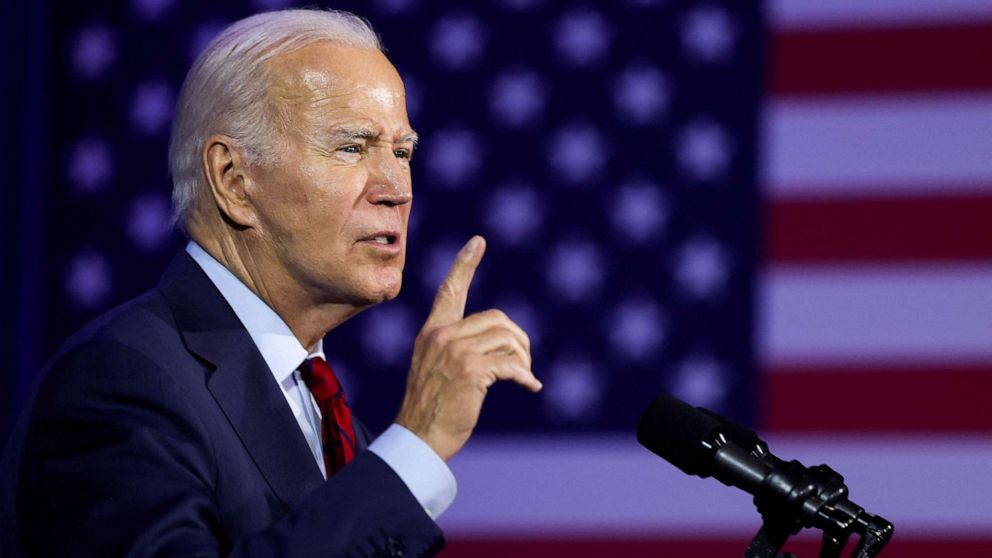美国总统乔·拜登(Joe Biden)周一宣布,425亿美元将从两党基础设施法他倡导将在全国范围内推广高速互联网接入。
根据白宫的说法,这笔资金将用于所有50个州、华盛顿特区和美国领土,旨在促进互联网接入,特别是生活在服务水平低下地区的7%的人,白宫表示,所有居民和小企业都可以连接到“到2030年可靠、负担得起的高速互联网”
在白宫发表的讲话中,拜登称这是一项“与富兰克林·德拉诺·罗斯福总统为美国农村供电同样具有历史意义的投资”。
他说:“为了让今天的经济为每个人服务,互联网接入就像电、水或其他基本服务一样重要。”
拜登和副总统卡玛拉·哈里斯计划启动为期三周的宣传活动,旨在宣传他们政府在全国各地的投资,包括2021年基础设施法和一系列其他立法,他们认为这些立法正开始切实改善美国人的生活。
它来自于拜登面临政治阻力关于他对经济的处理,这一直是选民在2024年选举中关注的问题。
周三,他计划发表白宫称为“拜登经济学”(Bidenomics)的重要演讲,他的顾问将他的经济哲学称为投资中产阶级。
这是试图重塑拜登在2020年竞选活动和担任总统期间一再重复的信息。
在接下来的三周里,政府高级官员计划在全美范围内展开,展示他倡导的立法如何开始给人们带来实实在在的好处,比如新的就业机会、新的桥梁,以及现在的新的互联网接入。
哈里斯已经在全国推广高速互联网接入,总统经常让观众想象他们是否不得不开车到麦当劳的停车场,让他们的孩子使用餐馆的互联网做作业。
拜登的幕僚长将这一举措比作罗斯福总统的农村电气化法案,该法案为全国各地的农民家庭提供了电力,并称该决定“有助于改变美国农村”。
杰夫·兹恩茨周日对记者说:“特别是对于数百万生活在农村地区的美国人来说,互联网已经瘫痪了很多。”。“有时甚至连上网都没有,我们都从日常生活中了解到,在这一点上,上网并不是一件‘美好的事情’,而是一种‘需要’和‘必须’的事情。”"
商务部长吉娜·雷蒙多告诉美国广播公司新闻,这笔钱将帮助大约850万没有互联网接入的美国家庭,以及数百万接入不可靠的家庭。
“[这是]中西部的一个小家庭农场,试图在网上买卖东西,但因为没有互联网,所以做不到。这是一个小生意,甚至可以考虑一家餐馆或商店,你知道,没有互联网,”她说。“这真的让人们退缩了。数百万的孩子不能在网上做作业。真的有太多的美国人不能在网上看病,不能在网上做作业,不能在网上转移业务。”
雷蒙多说,各州可以在7月1日开始提交他们的计划,然后这些钱将在“接下来的几个月内”发放出去。
拜登政府的一名高级官员告诉记者,这些投资将创造“超过15万个建筑类工作岗位,从劳工到电工再到通信工人。”
根据联邦通信委员会的数据,美国约有850万个地方,或全国约7%的地方没有高速互联网服务。
根据拜登政府的说法,各州周一了解了拨款将如何运作,每个州、华盛顿特区和波多黎各都收到了至少1亿美元。
总统将在周三的旅途中传达他的经济信息,届时他将前往芝加哥,更广泛地谈论他所关注的经济在许多方面的表现,特别是就业增长和低失业率。
他的两名高级顾问安妮塔·邓恩和迈克·多尼伦在周一发布的一份备忘录中写道:“拜登经济学植根于一个简单的理念,即我们需要自下而上,而不是自上而下地增长经济。”
作为一名在职者,拜登有优势利用他的办公室走遍全国,谈论他的政策对美国经济福祉产生的实际、具体的影响。
但是他还有很长的路要走。
面对顽固的通货膨胀,拜登是否能让人们相信他们现在过得更好,或者说如果他继续担任四年总统,而不是共和党,他们会过得更好,还有待观察。

2023年6月23日,美国总统乔·拜登在华盛顿特区五月花酒店参加一场政治活动。
Evelyn Hockstein/路透社
上个月,安ABC新闻/华盛顿邮报民意调查发现54-36%的美国人表示,再次竞选总统的前总统唐纳德·特朗普在任时在处理经济方面比拜登任期内做得更好。
他的顾问认为他有很多要谈的:一部变革性的基础设施法;芯片和科学法案,他们说这将启动国内制造业;以及通过冠状病毒救援计划进行的各种其他投资。
邓恩在周一表示:“如果‘里根经济学’是基于这样一种想法,即如果你为最富有的公司、社会上最富有的人减税,然后在某个时候这些人的残余将渗透到中产阶级和工人阶级,那么拜登经济学则完全相反。”MSNBC访谈录。“拜登经济学说,在这个经济体中,你发展经济的方式是你发展中产阶级。”
Biden announces how $40 billion for high-speed internet will be used, as he pitches 'Bidenomics'
President Joe Biden on Monday announced how $42.5 billion fromthe bipartisan infrastructure lawhe championed will be distributed to expand high-speed internet access across the country.
The funding will go to all 50 states, Washington, D.C., and U.S. territories, and is aimed at bolstering internet access particularly for the 7% of people who live in underserved areas, according to the White House, which said all residents and small business could be connected to "reliable, affordable high-speed internet by 2030."
In remarks from the White House, Biden called it an "equally historic investment" as the effort under President Franklin Delano Roosevelt to bring electricity to rural America.
"For today's economy to work for everyone, internet access is just as important as electricity or water or other basic services," he said.
Biden and Vice President Kamala Harris plan to kick off a three-week pitch aimed at touting their administration's investments across the country -- including the 2021 infrastructure law and a host of other legislation they argue is starting to make concrete improvements in Americans' lives.
It comes asBiden faces political headwindson his handling of the economy, which consistently is a noted issue with voters heading into the 2024 elections.
On Wednesday, he is scheduled to deliver what the White House is billing as a major speech on "Bidenomics" – what his advisers have labeled his economic philosophy of investing in the middle class.
It's an attempt to rebrand a message Biden has repeated time and time again on the 2020 campaign trail and as president.
Over the next three weeks, top administration officials plan to fan out across America to show how legislation he has championed -- his infrastructure law to the CHIPS and Science Act, a COVID-19 relief package and more -- is beginning to result in tangible benefits for people, like new jobs, new bridges and, now, new internet access.
Harris has already traveled the country promoting high-speed internet access, and the president often asks audiences to imagine if they had to drive to a McDonald's parking lot for their child to use the eatery's internet to do their homework.
Biden's chief of staff has likened the push to President Roosevelt's Rural Electrification Act, which delivered electricity to farming families across the country, saying that decision "helped transform rural America."
"For millions of Americans in rural communities in particular, the internet is down a lot," Jeff Zients told reporters Sunday. "Sometimes there's not even any access, and we all know from our day-to-day lives how internet access is not a 'nice to have' at this point -- but it's a 'need to have,' a 'must have.'"
Commerce Secretary Gina Raimondo told ABC News that the money would help about 8.5 million American households without internet access and millions more with unreliable access.
"[It's] a small family farm in the Midwest trying to buy and sell things online but can't because they don't have internet. It's a small business, or even think about a restaurant or a shop, you know, not having the internet," she said. "It really holds people back. It's millions of kids who can't do their homework online. It's really so many Americans who can't go to the doctor online, can't do their homework online, can't shift their business online."
States can start submitting their plans for that money on July 1, then the money will go out the door "over the next few months," Raimondo said.
A senior Biden administration official told reporters the investments would create "over 150,000 construction-type jobs, from laborers to electricians to communications workers."
High-speed internet service is unavailable in about 8.5 million locations in the United States, or about 7% of the country, according to the Federal Communications Commission.
States learned Monday how allocations will work, with every state, Washington, D.C., and Puerto Rico receiving at least $100 million, according to the Biden administration.
The president will take his economic message on the road Wednesday, when he travels to Chicago to talk more broadly about how the economy under his watch by many metrics, particularly job growth and low unemployment rates.
"Bidenomics is rooted in the simple idea that we need to grow the economy from the middle out and the bottom up—not the top down," two of his senior advisers, Anita Dunn and Mike Donilon, wrote in a memorandum released Monday.
As an incumbent, Biden has the advantage of using his office to travel the country and talk about the actual, concrete impacts his policies have had on Americans' economic well-being.
But he has a long hill to climb.
With stubborn inflation, it remains to be seen whether Biden can convince folks that they're better off now – or will be better off with him in the presidency for four more years, instead of a Republican.
Last month, anABC News/Washington Post pollfound that Americans by 54-36% said former President Donald Trump, who is running for president again, did a better job handling the economy when he was in office than Biden has done in his term so far.
His advisers argue he has a lot to talk about: a transformative infrastructure law; the CHIPS and Science Act, which they say will jumpstart domestic manufacturing; and various other investments through the coronavirus relief package.
"If 'Reaganomics' was based on the idea that if you cut taxes for the wealthiest corporations, the wealthiest people in the society, and then at some point the remnants of those will trickle down to the middle class and the working class, Bidenomics is the exact opposite," Dunn said during a Mondayinterview with MSNBC. "Bidenomics says that the way you grow the economy in this economy is you grow the middle class."






